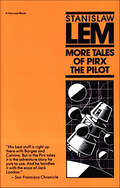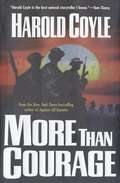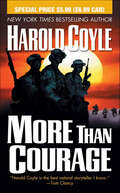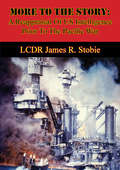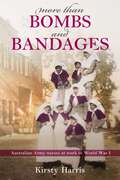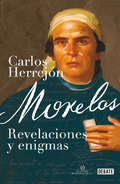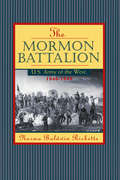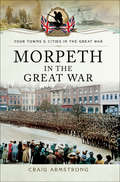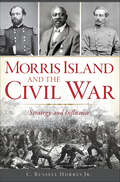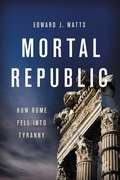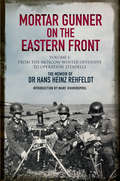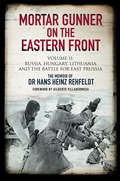- Table View
- List View
More Tales of Pirx The Pilot (Harvest)
by Stanislaw LemCommander Pirx, who drives space vehicles for a living in the galaxy of the future, here faces a new series of intriguing adventures in which robots demonstrate some alarmingly human characteristics. Translated by Louis Iribarne, assisted by Magdalena Majcherczyk and Michael Kandel. A Helen and Kurt Wolff Book
More Testing Times: Test Flying in the 1980s and '90s
by Mike Brooke Tom Morganfeld Tom MorgenfeldFollowing his first three successful books, describing his long career as a military pilot, Mike Brooke completes the story with more tales of test flying during the 1980s and ’90s. During this period his career changed to see him take control of flying at Farnborough and then at Boscombe Down, as well as off-the-cuff delivery missions to Saudi Arabia, ‘bombing’ in the name of science in the Arctic and the chance to fulfil a long-standing dream and fly the vintage SE.5a. This often hilarious memoir gives a revealing insight into military and civilian test flying of a wide range of aircraft, weapons and systems. As in his previous books, Brooke continues to use his personal experiences to give the reader a unique view of flight trials of the times, successes and failures. More Testing Times and its earlier volumes make for fascinating reading for any aviation enthusiast.
More Than Bombs and Bandages: Australian Army Nurses at Work in World War I (Big Sky Publishing Ser.)
by Kirsty HarrisMore than Bombs and Bandages exposes the false assumption that military nurses only nursed. Based on author Kirsty Harris' CEW Bean Prize winning PhD thesis, this is a book that is far removed from the 'devotion to duty' stereotyping offering an intriguing and sometimes gut wrenching insight into the Australian Army Nursing Service (AANS) during World War I.
More Than Conqueror (Grace Livingston Hill Ser. #11)
by Grace Livingston HillWhen Charlie Montgomery, a handsome soldier, declares his love for Blythe Bonniwell, she realizes she should be offended. But she isn't--in fact, she's honored! Blythe returns Charlie's love, and promises to remain faithfull to him while he is at war. Though thrilled at Blythe's response, Charlie knows all too well that the special mission he has been assigned means facing almost-certain death. He can offer Blythe little hope for his return or their future happiness. Yet, in the midst of fear and peril, Charlie and Blythe find a source of strength and peace that will keep them united forever. Grace Livingston Hill is the beloved author of more than 100 books. Read and enjoyed by millions, her wholesome stories contain adventure, romance, and the heart-warming triumphs of people faced with the problems of life and love. She was a pioneerr in popularizing Christian Fiction. Bookshare's library contains over fifty of her books with new ones being added regularly. Here is a sampling of Books in this series. Look for: #1 Where Two Ways Met, #2 Bright Arrows, #3 A Girl To Come Home To, #5 Kerry, #6 All Through The Night, #7 The Best Man, #13 In Tune With Wedding Bells, #14 Stranger Within The Gates, #15 Marigold, #16 Rainbow Cottage, #17 Maris, #18 Brentwood, #19 Daphne Deane, #22 Rose Galbraith, #24 By Way of the Silverthorns, #26 The Seventh Hour, #30, Matched Pearls, #46 Through These Fires, #53 Job's Niece, #67 A Daily Rate, #71 Exit Betty, #84 Cloudy Jewel and #95 Mary Arden.
More Than Conquerors
by Kay CorneliusA Southern debutante must choose between her Confederate sweetheart and a Yankee officer in this Civil War romance from the author of Love&’s Gentle Journey. Lucinda Matthews' life is perfect. Honey-blond with piercing gray eyes, she is Huntsville, Alabama's most admired debutante, not to mention the twinkle in the eye of her beloved fiancé, Ben Bradley. Then the Civil War invades the South, and Lucinda's life. Ben joins the Confederate forces as enemy troops occupy Lucinda's home. She finds solace in the arms of Yankee Major Seth Russell. But should she love this devilishly attractive man, the antagonist of everything she holds dear? Without his help, her father will probably be carried off to a Northern jail. When Ben returns, Lucinda must finally decide what it is her heart truly wants, and which man she loves: her childhood sweetheart, or her conqueror?
More Than Courage
by Harold CoyleCourage is often enough to drive a soldier forward, to cause him to climb out of his foxhole and face enemy fire. But it takes something else, something more than courage to keep HIM going when every instinct, every shred of reason dictates that he do otherwise. This hard truth becomes self-evident when the men belonging to Recon Team Kilo, a Special Forces A team operating deep in hostile territory, is overwhelmed by indigenous forces. Stripped of their leadership and unit cohesion, the survivors struggle to stay faithful to a code of conduct in the face of brutal imprisonment and an uncertain future. Isolated from their brethren, each man is forced to rely upon his own skills and strengths. Some rise to the occasion with a defiance that is unnerving to their captors and some draw upon an inner grace that sees them through their darkest hours. Others, alone and suffering, find themselves wavering as they are hammered by an unending drumbeat of depraved cruelty. The challenges faced by those selected to rescue the men of Recon Team Kilo are no less daunting, the catalysts that propel them and see them through any diverse. For Robert Delmont, Special Ops Plans Officer, a compelling need for atonement colors his recommendations. He steers the Army's senior leadership toward a course of action that allows him to become an active participant. Courage is not a factor for the commander of the unit selected to execute Delmont's plan. A dedicated professional, Lieutenant Colonel Harry Shaddock has no doubt that the men under his command will follow him anywhere--even into an operation designed to save fellow soldiers while putting his own in harm's way. While Dermont, Shaddock, and other members of the armed forces bend their collective efforts to save the survivors of Recon Team Kilo, the families of those men must endure a trial no less daunting. They must find a way to deal with their fears and their emotions as they stand on the sidelines watching their loved ones killed off, one by one, by a ruthless foe in a contest that demands more of them than any had imagined. In order to triumph, all must reach out and draw upon something within, something more than courage.
More Than Courage (Nathan Dixon #3)
by Harold CoyleCourage is often enough to drive a soldier forward, to cause him to climb out of his foxhole and face enemy fire. But it takes something else, something more than courage to keep HIM going when every instinct, every shred of reason dictates that he do otherwise.This hard truth becomes self-evident when the men belonging to Recon Team Kilo, a Special Forces A team operating deep in hostile territory, is overwhelmed by indigenous forces. Stripped of their leadership and unit cohesion, the survivors struggle to stay faithful to a code of conduct in the face of brutal imprisonment and an uncertain future. Isolated from their brethren, each man is forced to rely upon his own skills and strengths. Some rise to the occasion with a defiance that is unnerving to their captors and some draw upon an inner grace that sees them through their darkest hours. Others, alone and suffering, find themselves wavering as they are hammered by an unending drumbeat of depraved cruelty.The challenges faced by those selected to rescue the men of Recon Team Kilo are no less daunting, the catalysts that propel them and see them through any diverse. For Robert Delmont, Special Ops Plans Officer, a compelling need for atonement colors his recommendations. He steers the Army's senior leadership toward a course of action that allows him to become an active participant.Courage is not a factor for the commander of the unit selected to execute Delmont's plan. A dedicated professional, Lieutenant Colonel Harry Shaddock has no doubt that the men under his command will follow him anywhere--even into an operation designed to save fellow soldiers while putting his own in harm's way.While Dermont, Shaddock, and other members of the armed forces bend their collective efforts to save the survivors of Recon Team Kilo, the families of those men must endure a trial no less daunting. They must find a way to deal with their fears and their emotions as they stand on the sidelines watching their loved ones killed off, one by one, by a ruthless foe in a contest that demands more of them than any had imagined. In order to triumph, all must reach out and draw upon something within, something more than courage.At the Publisher's request, this title is being sold without Digital Rights Management Software (DRM) applied.
More Than a Lover: A Regency Historical Romance (Rakes in Disgrace #4)
by Ann LethbridgeWill he unlace all of her secrets? Former captain Bladen Read knows respectable Caroline Falkner would never look twice at an illegitimate ruffian like him. But when he's suddenly thrown into the role of her protector he discovers the undercurrent of tension runs both ways... At first Caro tries to resist the pull of attraction, for Blade is a link to the scandalous past she buried long ago to protect her son. Although when the opportunity to explore this rake's expertise in the bedroom presents itself, temptation proves too much to resist!
More Than a Mistress (Rakes in Disgrace #2)
by Ann LethbridgeCharles Mountford, Marquis of Tonbridge, has long felt the weight of responsibility. He knows he must do his duty and take a wife. But when he's left snowbound with the unconventional Miss Honor Meredith Draycott, he finds that his inner rogue wants to come out to play....Merry doesn't need a man-no matter how handsome he is! Sadly, society takes a different view. Charlie is more than happy to make her socially acceptable, but only if she acts publicly as his betrothed and privately as his mistress!
More Time for Politics: Diaries 2001-2007
by Tony BennWhen Tony Benn left Parliament after 51 years he quoted his wife Caroline's remark that now he would have 'more time for politics'. And so this has proved: in the first seven years of this century he has helped reinvigorate national debate through public meetings, mass campaigns and appearances in the media, passionately bringing moral and political issues to wide audiences. And throughout, as ever, he has been keeping his diaries.Commenting on the demise of the New Labour project from the re-election of Tony Blair in 2001 to the ultimate foreign policy disasters of Afghanistan and Iraq, he gives other prescient accounts of the government's by-passing of Cabinet, parliament and the party, of the 'war on terror', the debate about Islam, globalisation and the changes in British society. Although he is no longer in power or in parliament, Tony Benn remains a figure of enormous respect whose direct views, honestly expressed, have often awakened the national conscience. His latest Diaries, human and challenging in turn, are an enthralling read.
More To The Story: A Reappraisal Of US Intelligence Prior To The Pacific War
by LCDR James R. StobieEarly on Sunday, 7 December 1941, the air and naval forces of the Imperial Japanese Navy attacked the U.S. Pacific Fleet at anchor in Pearl Harbor, Hawaii. President Franklin D. Roosevelt (FDR) recorded the day as "a date which will live in infamy" in his speech to a joint session of Congress. Subsequent investigations and histories judged U.S. intelligence as unprepared in its failure to predict the attack at Pearl Harbor. Yet FDR also listed the other locations Japan attacked in those first twenty-four hours starting with the attack at Kota Bharu in Malaya. Reviewing U.S. intelligence estimates and "war warning" messages against Imperial Japanese war plans and actions, U.S. intelligence understood Imperial Japan's intentions and plans far better than is recorded. Of the places listed in the 27 November 1941 "war warning"--"the Philippines, Thai or Kra [Malay] Peninsula and possibly Borneo"--two were attacked on that first day of war and the last, Borneo, a week later. On that first day of war, Japan also attacked Guam, Hong Kong, Singapore, and Wake and Midway Islands, the latter two reinforced against impending war with Japan in early December 1941 by U.S. aircraft carriers. The surprise of the attack on the U.S. Pacific Fleet overshadows the accuracy of U.S. intelligence estimates prior to the Pacific War.
More than Bombs and Bandages
by Kirsty HarrisMore than Bombs and Bandages exposes the false assumption that military nurses only nursed. Based on author Kirsty Harris&’ CEW Bean Prize-winning PhD thesis, this is a book that is far removed from the &‘devotion to duty&’ stereotyping offering an intriguing and sometimes gut-wrenching insight into the Australian Army Nursing Service (AANS) during World War I. More than Bombs and Bandages provides rich pickings for all those interested in nursing history, women in the Australian military the application of medical treatments and World War I. What I enjoyed most about is Dr Kirsty Harris&’s ability to reflect those nurses voices in a way that was so real – one could be there, the settings were so well understood from her research and the language kind of made a time warp in the reading. Very satisfying. As you know I have that Peter Rees book, but I could not get into it after reading the historical one. It was like comparing a great documentary to Facebook trivia!!!Rev&’d Dr Barbara Oudt
More than One Night (Wildfire Ridge)
by Heatherly BellShe had one night with a marineAnd now she’s in commandA one-night stand so incredible, Jill Davis couldn’t forget. Memories so delectable, they sustained Sam Hawker through his final tour. Three years later, Jill is unexpectedly face-to-face with her legendary marine lover. And it’s clear their chemistry is like gas and a match. Except Sam is her newest employee. That means hands off, sister! Except maybe…just this once? Ooh-rah!
More than a Soldier
by Irene OnoratoThere’s more than one way to be a hero . . .Former Special Forces soldier Hank Fleming is living a safe, quiet life in upstate New York, but there are days he isn’t sure he’s going to make it. The sole survivor of a devastating grenade attack in Afghanistan, he is still scarred, physically and emotionally. He hangs on to his faith and tries to keep moving forward, waiting for the day that something—or someone—can make him feel whole again.Cindy Giordano is searching too—for her biological family and a fresh start. When her journey to find her brother, Edward, leads to Hank’s front door, she is instantly drawn to Hank . . . and instantly wary. With her ex-fiancé’s betrayal still fresh in her mind, friendship is about all she can muster.When shadows from Cindy’s past threaten, Hank’s protective instincts shift into high gear, and he realizes everyone has their own battles to fight. But the road to healing would be much sweeter with the right person by his side . . .
Morelos: Revelaciones y enigmas
by Carlos HerrejónPiense en un joven estudiante, inteligente, disciplinado, con madera de líder y sentido del humor. Póngale nombre: José María. Póngale rostro: rasgos duros, cruce de etnias y mirada penetrante. Ese muchacho escucha a su rector, Miguel Hidalgo. Juntos entrarán en la historia. Esta biografía de Morelos -la más acuciosa hasta ahora- revela el camino que siguió ese arriero, ese estudiante y cura. Lo aleja del bronce, del mármol y de los mitos. Y nos entrega una de las vidas más fascinantes, más humanas y enternecedoras que puedan imaginarse. Entre la ilustración y la pobreza, entre el ansia de libertad y el afán por reordenar la insurgencia, entre la genialidad militar y la ingenuidad seria y socarrona a la vez, ahí se ubica José María Morelos. Justo entre lo sublime de los Sentimientos de la Nación y la brutalidad de la guerra sin cuartel. Con esta obra, el investigador Carlos Herrejón ha pintado el mejor retrato de uno de los héroes más mencionados y poco conocidos en algunas de sus facetas: revelaciones y enigmas.
Mormon Battalion: United States Army of the West, 1846-1848
by Norma RickettsFew events in the history of the American Far West from 1846 to 1849 did not involve the Mormon Battalion. The Battalion participated in the United States conquest of California and in the discovery of gold, opened four major wagon trails, and carried the news of gold east to an eager American public. Yet, the battalion is little known beyond Mormon history. This first complete history of the wide-ranging army unit restores it to its central place in Western history, and provides descendants a complete roster of the Battalion's members.
Morpeth in the Great War (Your Towns & Cities in the Great War)
by Craig ArmstrongMorpeth played a key role in Northumberland's war effort. As a market town and the seat of government of the county authority, the town was significant in the coordination of Northumberlands war effort. With a wide rural hinterland, it played a huge part in the production and dispersal of vital food. The town also occupied a position on the fringes of the Northumberland coal district, and many of the men and businesses of Morpeth were engaged in the equally vital work of mining. The town shared a proud tradition of military service with the wider region, reflected in the huge numbers of Morpeth men and women who came forward for service in the military or in roles such as nursing. It was a recruitment centre, with its own unit of the 1/7th (Territorial) battalion, Northumberland Fusiliers.For many of those left behind in Morpeth the war was a time of fear and hardship. This book includes accounts of the struggles that many families faced in coping with wartime policies, severe shortages, rising wartime prices, longer working hours and endless worry, sometimes in the face of accusations of drunkenness or idleness from the authorities and unfair criticism of the rural districts recruiting record. Despite the hardships, Morpethians continued to provide incredible charitable support right up until the end of the war, in addition to their work efforts. These momentous efforts are explained throughout this book, which is a poignant testimony to the bravery, self-sacrifice and determination of the people of Morpeth during the Great War.
Morris Island and the Civil War: Strategy and Influence (Civil War Series)
by C. Russell Horres Jr.From Charleston's doorstep, Morris Island held a critical position in the Civil War. It was first used by Confederates to assist in the bombardment of Fort Sumter and later became the scene of an epic struggle to prevent Union forces from gaining control. After the battle, the roles reversed, and Union forces used the site to bombard Fort Sumter and Charleston. Hundreds lost their lives, and both sides expended a vast amount of war capital for what appeared to be little value. Confederates greatly underestimated how events at Morris Island played into the hands of the Civil War's master strategist, Abraham Lincoln. Author C. Russell Horres Jr. offers the complete story of Morris Island in the War Between the States.
Mort: A Discworld Novel (Death #1)
by Terry PratchettNew York Times bestselling author Terry Pratchett makes Death a central character in Mort, a fabulous installment in Discworld, the fantasy cosmos where even the angel of darkness needs some assistance. Death comes to everyone eventually on Discworld. And now he's come to Mort with an offer the young man can't refuse. (No, literally, can't refuse since being dead isn't exactly compulsory.) Actually, it's a pretty good deal. As Death's apprentice, Mort will have free board and lodging. He'll get use of the company horse. And he won't have to take any time off for family funerals. But despite the obvious perks, young Mort is about to discover that there is a serious downside to working for the Reaper Man . . . because this perfect job can be a killer on one's love life.Terry Pratchett's profoundly irreverent, bestselling novels have garnered him a revered position in the halls of parody next to the likes of Mark Twain, Kurt Vonnegut, Douglas Adams, and Carl Hiaasen.
Mortal Crimes: The Soviet Penetration of the Manhattan Project
by Nigel WestNigel West has studied the recently revealed documents about Soviet espionage against the Western Allies during and after World War II and has for the first time painted the complete picture of how the Soviet Union stole the secrets of the atomic bomb. <P><P>The investigations by the British, Canadian, and US Military counterintelligence services through the Venona intercepts are placed in proper context and made intelligible by a master espionage history writer. What is revealed is the extent of the penetration by the NKVD and KGB of the most secret technologies of the era and how the West protected itself. A new and revised edition.
Mortal Republic: How Rome Fell into Tyranny
by Edward J. WattsA new history of the Roman Republic and its collapse In Mortal Republic, prize-winning historian Edward J. Watts offers a new history of the fall of the Roman Republic that explains why Rome exchanged freedom for autocracy. For centuries, even as Rome grew into the Mediterranean's premier military and political power, its governing institutions, parliamentary rules, and political customs successfully fostered negotiation and compromise. By the 130s BC, however, Rome's leaders increasingly used these same tools to cynically pursue individual gain and obstruct their opponents. As the center decayed and dysfunction grew, arguments between politicians gave way to political violence in the streets. The stage was set for destructive civil wars--and ultimately the imperial reign of Augustus. The death of Rome's Republic was not inevitable. In Mortal Republic, Watts shows it died because it was allowed to, from thousands of small wounds inflicted by Romans who assumed that it would last forever.
Mortar Gunner on the Eastern Front Volume I: From the Moscow Winter Offensive to Operation Zitadelle
by Dr. Hans Heinz RehfeldtThe first volume of the World War II diaries of Nazi mortar gunner constantly pushed to the brink of death while fighting against Russia. Following his Abitur (A-levels) in 1940, Hans Heinz Rehfeldt volunteered for Germany&’s Panzer Arm but was trained on the heavy mortar and heavy MG with Grossdeutschland Division. In 1941, he was on the Front fighting for the city of Tula, south of Moscow. Battling in freezing conditions without winter clothes, they resorted to using those taken from Soviet corpses. In 1942, his battalion fought near Oriel, suffered heavy losses, and disbanded. Ill with frostbitten legs, Rehfeldt was treated in hospital, and once recovered, was dispatched back to the Front. Following various battles (Werch, Bolchov) his battalion again suffered heavy losses and it merged. In agony from severe frostbite to his legs, Rehfeldt defied the odds and astonished his surgeon when he walked again. He was promoted from Gunner to Trained Private Soldier in 1942, and to Corporal for bravery in the field in 1943. He was also awarded numerous honors, including the Wound Badge and the Infantry Assault Badge. On 3 May 1945, he was captured by U.S. Forces and held as a POW for one month in a camp at Waschow before internment in Holstein where he was released in July 1945, after agreeing to work on the land. Then, in December 1945, he put his past behind him and began studying for his future career: veterinary medicine.
Mortar Gunner on the Eastern Front Volume II: Russia, Hungary, Lithuania, and the Battle for East Prussia
by Dr. Hans Heinz RehfeldtThis second volume of a Nazi soldier&’s WWII diary continues the chronicle of his experiences on the Easter Front. A member of the Hitler Youth before the outbreak of World War II, Hans Heinz Rehfeldt volunteered for the Grossdeutschland&’s panzer arm in 1940 and fought with them for nearly the entire war. He was decorated with the Iron Cross First and Second Class, the Eastern Front Medal, the Close Combat Clasp, and the Infantry Assault Badge. His diaries offer a historically significant chronicle of German military actions on the Eastern Front as well as a rare look inside the mind of a committed Nazi soldier. This second volume of Rehfeldt&’s wartime diary covers his experience as a platoon commander in Romania, East Prussia and Lithuania during 1944. After being transferred by ship from Memel to Königsberg later that year, he took part in the battles for Ostprussen. Fleeing Russian imprisonment, he traveled west, where he fell into American captivity on May 3rd, 1945. In July, he was released and returned home.
Mortar Gunner on the Eastern Front Volume II: Russia, Hungary, Lithuania, and the Battle for East Prussia
by Dr. Hans Heinz RehfeldtThis second volume of a Nazi soldier&’s WWII diary continues the chronicle of his experiences on the Easter Front. A member of the Hitler Youth before the outbreak of World War II, Hans Heinz Rehfeldt volunteered for the Grossdeutschland&’s panzer arm in 1940 and fought with them for nearly the entire war. He was decorated with the Iron Cross First and Second Class, the Eastern Front Medal, the Close Combat Clasp, and the Infantry Assault Badge. His diaries offer a historically significant chronicle of German military actions on the Eastern Front as well as a rare look inside the mind of a committed Nazi soldier. This second volume of Rehfeldt&’s wartime diary covers his experience as a platoon commander in Romania, East Prussia and Lithuania during 1944. After being transferred by ship from Memel to Königsberg later that year, he took part in the battles for Ostprussen. Fleeing Russian imprisonment, he traveled west, where he fell into American captivity on May 3rd, 1945. In July, he was released and returned home.
